It looks like you're using an Ad Blocker.
Please white-list or disable AboveTopSecret.com in your ad-blocking tool.
Thank you.
Some features of ATS will be disabled while you continue to use an ad-blocker.
14
share:
I cam across an intriguing image from Gobekli Tepe, it's identified as a monumental porthole with stone sculptures which doesn't really do it
for me, i was thinking more megalithic slab involving baby alien-human hybrids creeping toward mysterious vaults purpose unknown, like you do, but
anyway i made further enquiry.
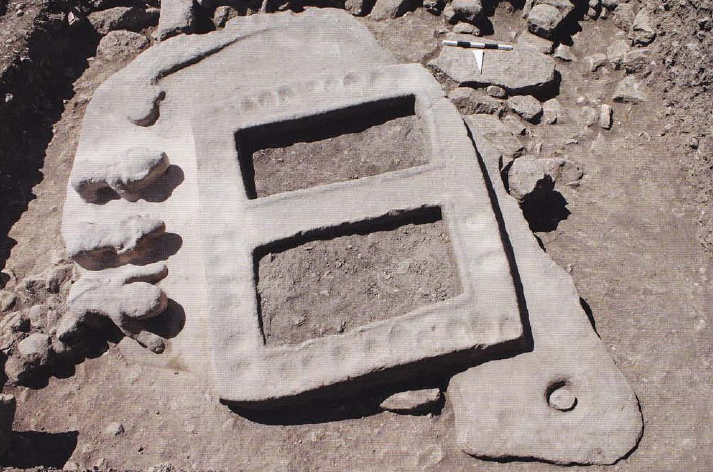
It seems there are quite a few large and sunken basins which seem to have been involved in the production of beer;
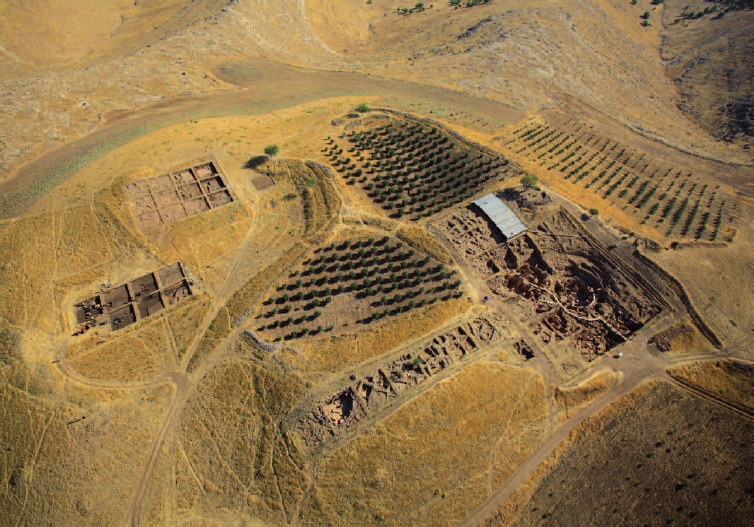
I like the way they used large onager bones to stir their brew, this must have added greatly to the flavour.
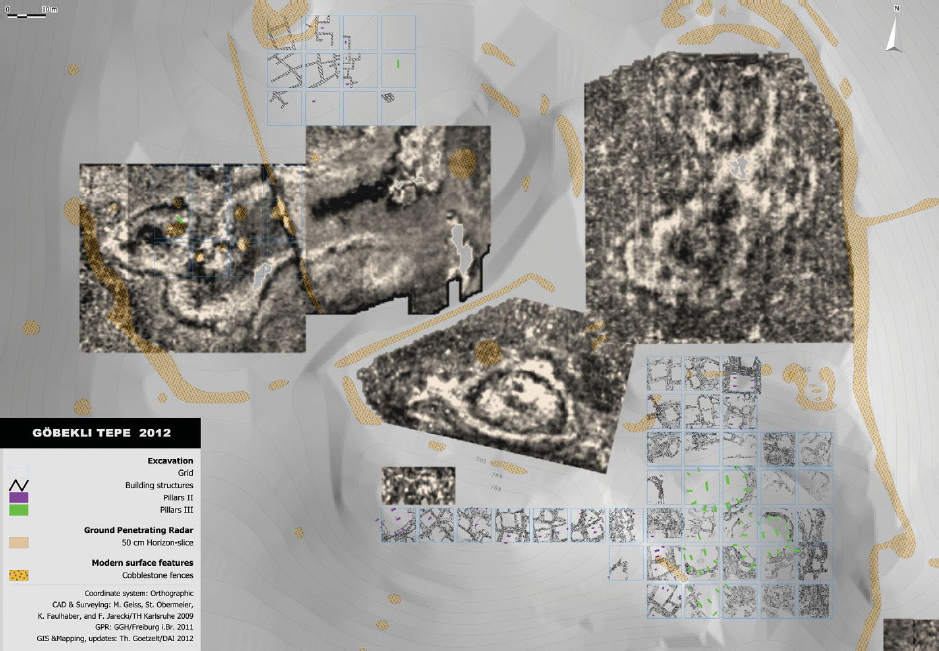
So it seems in part Gobekli Tepe functioned as a very large brewery, probably in the context of the abundant feasting known to have taken place there, it's seeming primary purpose, this has given rise to all sorts of questions such as did civilization develop as a means to produce beer, certainly the drinking of it seems to have been the favourite pastime of the Anunnaki.
So then what of the three creeping alien-human baby hybrids, unlikely they would be such if the brewing of beer is what was involved, and upon closer inspection perhaps just newts or some such that had a liking for the beer, thus giving rise to the saying 'as drunk as newts', a saying which the evidence strongly suggests dates back 11,000 years.
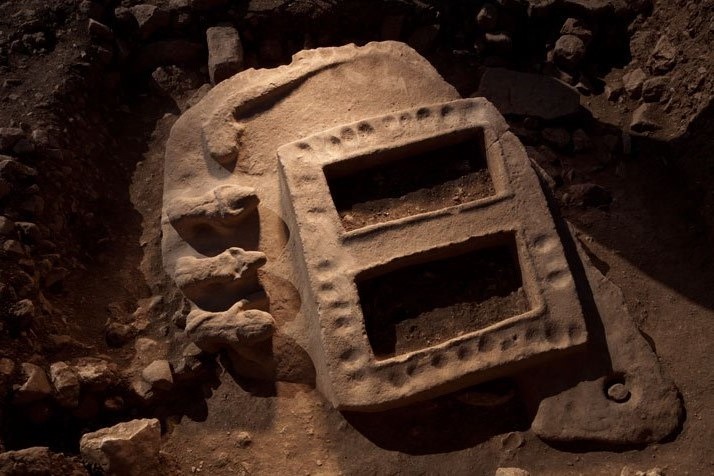
All from this paper;
The Role of Cult and Feasting in Neolithic emergence

It seems there are quite a few large and sunken basins which seem to have been involved in the production of beer;
Chemical analysis was recently conducted also on a group of large limestone basins from Gobekli Tepe. Six barrel- and trough-like vessels have been found in PPNB contexts. Due to their size and capacities of up to 160 litres they are static, integral parts of particular rooms , but fragments of such vessels appear in all strata. Some of them show grayish-black residues adhering to the lower parts of vessels.
First results show probable evidence of oxalate for some samples,but the applied Feigl ltest was not sensitive enough to give reproducible results.
Oxalate develops during and can indicate the production of malt and beer. A complete scapula of an onager was found at the bottom of one . A very similar find is known from Tell ‘Abr in Syria, where five large limestone vessels stood on the floor of a structure described as a “communal building”, and a large bone lay withinone of the vessel. These bones could well have been used to stir up the contents of the vessels or to skim parts of it.

I like the way they used large onager bones to stir their brew, this must have added greatly to the flavour.
This and the presence of a hearth encouraged the excavators to interpret the room as a kitchen area.Since the simplest brewing process would need, in addition to cereal processing equipment,only large containers for malting and mashing, this ‘kitchen’ could have produced beer as well. In Gobekli Tepe, the occurrence of beer making is not yet certain, but as signs of habitation are also absent, it is a possibility that not every step of production was carried out there.
The grain may have been malted at nearby settlements and been brought there only on special occasions. Genetic analyses have shown that the domestication of single-grained einkorn and emmer wheat took place around the Karacada in close vicinity to Gobekli Tepe. It is an intriguing thought that brewing and the domestication of wheat might be interrelated

So it seems in part Gobekli Tepe functioned as a very large brewery, probably in the context of the abundant feasting known to have taken place there, it's seeming primary purpose, this has given rise to all sorts of questions such as did civilization develop as a means to produce beer, certainly the drinking of it seems to have been the favourite pastime of the Anunnaki.
it seems obvious that repetitive feasts of the amplitude implied at Gobekli Tepe must have placed stress on the economic production of hunter-gatherer groups. Maybe in response to the demand, new food sources and processing techniques were explored. In this scenario, religious beliefs and practices may have been a key factor in the adoption of intensive cultivation and the transition to agriculture. Archaeological and chemical evidence further suggests that this innovation may have been fuelled by alcoholic beverages
So then what of the three creeping alien-human baby hybrids, unlikely they would be such if the brewing of beer is what was involved, and upon closer inspection perhaps just newts or some such that had a liking for the beer, thus giving rise to the saying 'as drunk as newts', a saying which the evidence strongly suggests dates back 11,000 years.

All from this paper;
The Role of Cult and Feasting in Neolithic emergence
edit on Kam43098vAmerica/ChicagoThursday0930 by Kantzveldt because: (no reason given)
If you brew it, they will come?
I find it fascinating that we can find residue and analyze it after all these years. It kind of lends a porthole into the past. I wonder if techniques from this area migrated into ancient Egypt?
I find it fascinating that we can find residue and analyze it after all these years. It kind of lends a porthole into the past. I wonder if techniques from this area migrated into ancient Egypt?
Mystery solved.
Gobekli Tepe was the first bar.
Actually, nice thread OP. Very interesting.
Gobekli Tepe was the first bar.
Actually, nice thread OP. Very interesting.
a reply to: MystikMushroom
Yes Neolithic developments reached Egypt around 6,000 BC and they developed their own party scene.
a reply to: chiefsmom
I know bar-maids were very important in Sumerian culture and the Goddess of Beer Ninkasi, one of the primary roles of women was making beer.
Yes Neolithic developments reached Egypt around 6,000 BC and they developed their own party scene.
a reply to: chiefsmom
I know bar-maids were very important in Sumerian culture and the Goddess of Beer Ninkasi, one of the primary roles of women was making beer.
edit on Kam43098vAmerica/ChicagoThursday0930 by Kantzveldt because: (no reason given)
edit on
Kam43098vAmerica/ChicagoThursday0930 by Kantzveldt because: (no reason given)
Makes one wonder if those little newts could also have been the origin of the phrase "Bottoms up!"
It comes as no surprise that beer or mead was in existence then, but the case for beer vats at Gobekli Tepe is rather unproven though, don't you think?
It comes as no surprise that beer or mead was in existence then, but the case for beer vats at Gobekli Tepe is rather unproven though, don't you think?
a reply to: aboutface
No they seem pretty convinced the basins were involved in beer making, it was an award winning paper in 2012 and considered important in raising the question of beer before bread as the reason for the cultivation of grains.
a reply to: Silcone Synapse
I suppose you'd have to buy Ninkasi Beer to fully appreciate her qualities.
No they seem pretty convinced the basins were involved in beer making, it was an award winning paper in 2012 and considered important in raising the question of beer before bread as the reason for the cultivation of grains.
a reply to: Silcone Synapse
I suppose you'd have to buy Ninkasi Beer to fully appreciate her qualities.
Beer goddess Nin-kasi was a venerable and long-lasting deity, for she appears in god lists and other texts from the Early Dynastic period (2900-2350 B.C.E.). She was "the personification of beer and presided over its manufacture" . Her name possibly means "Lady Who Fills the Mouth (with Beer)."
Lately the ancient beer goddess has been experiencing a resurgence of worshipful, if commercial, interest. The first "Hymn to Ninkasi" outlines in some detail how the ancient Mesopotamians made their beer. Eventually someone had to try to make it. In 1989, the Anchor Brewing Company in California did just that and produced a limited edition of the beer from a recipe decoded from the Hymn. The brewers called it "Ninkasi Beer"
edit on Kam43098vAmerica/ChicagoThursday0930 by Kantzveldt because: (no reason given)
What's that snake doing???
Why's he eyeballing the others as they decide if they are gonna get drunk or not...
Maybe eve drank the Apple cider
Why's he eyeballing the others as they decide if they are gonna get drunk or not...
Maybe eve drank the Apple cider
a reply to: Kantzveldt
What this proves, these Gobeli folks were no accidental tourists (read nomads), but were there to stay, cultivate soil and enjoy their time on Earth drinking beer. And if any luck, they did some spirits too. These are signs of culture and civilisation. When you can drink yourself drunk, you by definition do have (yeast) culture and know how to behave (un)civilised...
What this proves, these Gobeli folks were no accidental tourists (read nomads), but were there to stay, cultivate soil and enjoy their time on Earth drinking beer. And if any luck, they did some spirits too. These are signs of culture and civilisation. When you can drink yourself drunk, you by definition do have (yeast) culture and know how to behave (un)civilised...
Also it looks to me like some sort of game board.. Place your bets in the depressions while critters do battle....
OMG POKEMON IS REALZ!
For real tho... Frog fighting?
OMG POKEMON IS REALZ!
For real tho... Frog fighting?
a reply to: mindseye1609
I dunno that whole thing is odd, but like you say there is the large snake also, an impressive piece to carve from a single slab.
a reply to: Stormdancer777
There is the strange totem were i think four successive generations can be seen giving birth the one to the other, giving birth just as they are being born, they did have some odd ideas. That's also the reason my first consideration was that they were babies of sorts, because they looked quite similar to the totem figures
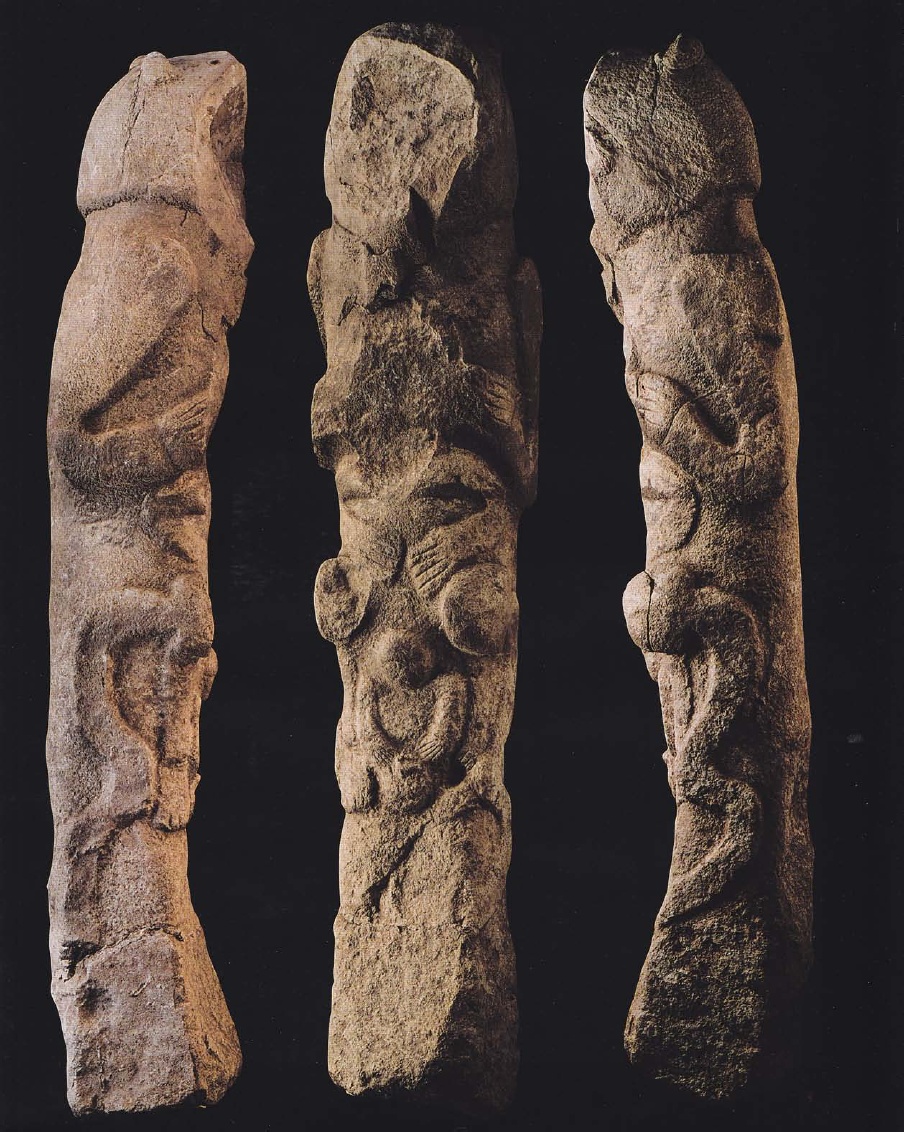
I dunno that whole thing is odd, but like you say there is the large snake also, an impressive piece to carve from a single slab.
a reply to: Stormdancer777
There is the strange totem were i think four successive generations can be seen giving birth the one to the other, giving birth just as they are being born, they did have some odd ideas. That's also the reason my first consideration was that they were babies of sorts, because they looked quite similar to the totem figures

edit on Kpm43098vAmerica/ChicagoThursday0930 by Kantzveldt because: (no reason given)
The recipe for mead online is
1 pound, honey
1 ounce, hops
2 tablespoons, yeast nutrient
1 package, brewers yeast (ale yeast)
1 gallon, water
Could the indentations beside the trough be the recipe? Put the right stuff in the indentations then scoop them into the trough. Need someone with better knowledge of how and what quantities to use for that size of a brewery.
they could have there to ladle out the beer and that's where they drank from either explanation works for them.
1 pound, honey
1 ounce, hops
2 tablespoons, yeast nutrient
1 package, brewers yeast (ale yeast)
1 gallon, water
Could the indentations beside the trough be the recipe? Put the right stuff in the indentations then scoop them into the trough. Need someone with better knowledge of how and what quantities to use for that size of a brewery.
they could have there to ladle out the beer and that's where they drank from either explanation works for them.
Nutritional carbohydrates can be preserved at length by the brewing process. Maybe it's because of the alcohol and or the aggressive
yeast...?
Maybe they were placed around the vats to scare rodents away. I don't want rats near my vats.
Sorry, I don't know why that is the first thing I thought when I saw the picture. Not cracking a joke.
Sorry, I don't know why that is the first thing I thought when I saw the picture. Not cracking a joke.
new topics
-
A Flash of Beauty: Bigfoot Revealed ( documentary )
Cryptozoology: 4 hours ago -
Fire insurance in LA withdrawn months ago
General Conspiracies: 6 hours ago
top topics
-
Fire insurance in LA withdrawn months ago
General Conspiracies: 6 hours ago, 7 flags -
A Flash of Beauty: Bigfoot Revealed ( documentary )
Cryptozoology: 4 hours ago, 5 flags -
Bizarre Labour Party Tic Toc Video Becomes Even More Embarrassing
Regional Politics: 14 hours ago, 4 flags
active topics
-
Planned Civil War In Britain May Be Triggered Soon
Social Issues and Civil Unrest • 30 • : andy06shake -
Regent Street in #London has been evacuated due to a “bomb threat.”
Other Current Events • 8 • : TimBurr -
A Flash of Beauty: Bigfoot Revealed ( documentary )
Cryptozoology • 3 • : BeyondKnowledge3 -
Fire insurance in LA withdrawn months ago
General Conspiracies • 23 • : Flyingclaydisk -
Judge rules president-elect Donald Trump must be sentenced in 'hush money' trial
US Political Madness • 86 • : Flyingclaydisk -
Trump says ownership of Greenland 'is an absolute necessity'
Other Current Events • 86 • : WeMustCare -
The Truth about Migrant Crime in Britain.
Social Issues and Civil Unrest • 44 • : angelchemuel -
My personal experiences and understanding of orbs
Aliens and UFOs • 41 • : WeMustCare -
-@TH3WH17ERABB17- -Q- ---TIME TO SHOW THE WORLD--- -Part- --44--
Dissecting Disinformation • 3982 • : WeMustCare -
Los Angeles brush fires latest: 2 blazes threaten structures, prompt evacuations
Mainstream News • 298 • : Flyingclaydisk
14

